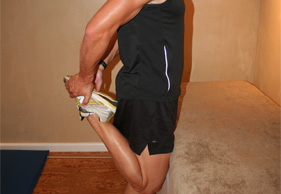Runners know they’re supposed to stretch their leg muscles on a regular basis, but most either don’t do it at all, or they do it all wrong, often leading to instability and injury. Here are some of the stretches that all runners should do – and a few to avoid at all costs! – By Sean Falconer
In part one (A Stretch Too Far in our March edition), we took an in-depth look at stretching with physiotherapist Benita De Witt, and she explained that the only muscles runners should stretch are the power muscles on the outer sides of the legs. These mobilisers do most of the work when you run and thus tend to shorten. The stabilising muscles on the inner sides of the legs tend to be weaker and thus lengthen, and therefore should not be stretched further, as this can lead to knee, calf or foot injuries.
Benita explains that there are certain ‘correct’ stretches for runners. “I recommend just three stretches that cover all the bases.
The first is for the quads, which stretches everything on the front of the leg, and you can choose between two ways of doing this stretch.
Then there are the two bum stretches: one sitting against the wall, which stretches the full length of the back of the legs, and the standing bum stretch, which targets the back and bum. You need to do both bum stretches, as they are complimentary. All these stretches should be held for just two seconds, then released and repeated five times.”
Benita, who developed the Lyno Method to determine where treatment should be focused to restore balance and eliminate chronic recurring injuries, says that it is important to compare the sides of the body. “If one side is tighter than the other – and by that I mean it actually has less range of movement, not just that it feels tighter – then you need to stretch the short side only. Once both sides are equal, you can work towards full range of movement.”
The Sitting Bum Stretch
Sit with your back against a wall and your legs straight in front of you. Lift one knee up to your chest, then bend the knee 90 degrees and move your foot towards the wall. Use your arms to pull the knee and foot towards your chest, keeping the foot and knee in line with each other.
The Standing Bum Stretch
Stand in front of a table that is the height of your hanging fist. Place one knee on the table in line with the hip and bend the knee 90 degrees. Your standing foot should be straight and in line with the other hip and shoulder. Hold the knee down on the table, keep your back straight and bend from the hips, trying to touch the table with your nose.
The Kneeling Quad Stretch
Kneel in front of a wall with one foot against the wall and the other knee two foot-lengths away from the wall. Make sure your bottom knee, hip and shoulder are in line, and keep your body straight. Hold the back foot with both hands and pull it towards the buttocks.
The Standing Quad Stretch
Stand against a table and bend one knee to lift the foot to the buttocks. Keeping the body straight and knees together, use both hands to pull the foot towards the buttocks. Then move the knee backwards as far as you can.
Leave Those Calves
Benita has strong sentiments about stretching the calf muscles: just don’t do it! “I never tell any of my athletes to stretch their calf muscles, because most of the time they are too long already. I can quickly check this with the calf length test, and if they do need to stretch their calves, I make them to do the two bum stretches, as that also stretches the calves.”
To test your calf length, stand barefoot, feet slightly apart, and raise the front of one foot as high as you can while keeping the heel on the ground. Ask a friend to see if they can put two fingers under the ball of the foot behind both the big and small toes. If you are able to lift the foot higher than two fingers, your calf is over-stretched. If you cannot fit two fingers under the foot, your muscle is too tight.
The Wrong Way!
Benita says that many common stretching techniques target the inner side of the leg, often leading to instability and injury. Therefore, she strongly recommends that you replace these wrong stretches with the right stretches described above.
Groin adductor Stretch
Lying Bum Stretch
One handed standing quad stretch
Leaning Inner Leg Stretch
Straight Leg Hamstring Stretch
‘Push it over’ Calf Stretch
Hanging Achilles Stretch
Missed part one?
You can read the first part of this article at www.modernathlete.co.za – you’ll find it in Body Science under the In the Magazine section.

